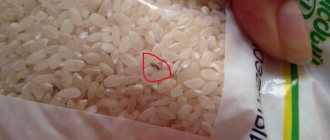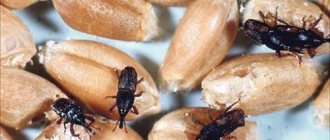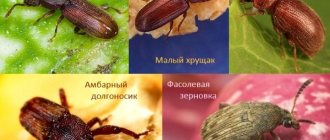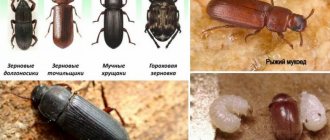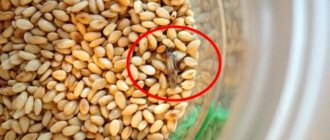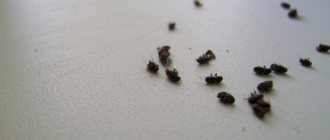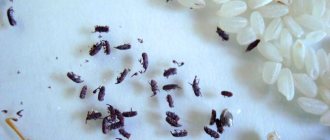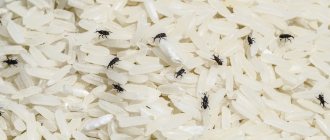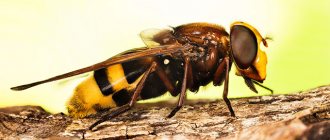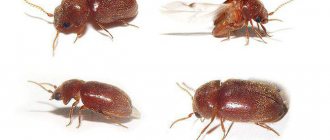Care and cleaning
2
10 487
Share
Every housewife knows first-hand what bugs are in the kitchen. These harmful insects appear unexpectedly and out of nowhere. In addition to the fact that they spoil food, bugs cause a lot of unpleasant sensations and leave behind traces of their vital activity.
Bugs in the kitchen contradict sanitary standards and the aesthetics of the home
- Reasons for bugs appearing in food and cupboards
- What bugs are found in cereals, flour
- How to get rid of insatiable parasites once they have appeared
- Preventive measures in the kitchen
- Conclusion
What kind of kitchen pests are they?
At first glance, kitchen bugs are all the same. However, several types are distinguished depending on color and habitat:
- bread grinders are one of the most voracious bugs, the body with hairs has a brown tint, the size reaches 4 mm;
- large flour beetles - a large beetle, an adult reaches 12–18 mm, the body is black-brown, slightly shiny;
- small flour beetles - small bugs with a reddish tint and short antennae, size 3 mm;
- red mucoeds are small coleopterous insects from red to brown in color with long antennae, approximately up to 2 mm;
- Suriname mucoeds are small black-brown bugs with a long matte body, reaching 1.8–3.5 mm;
- short-whiskered mucoeds are the smallest of the order of mucoeds, have a yellowish color with a rusty tint, size 1.5–2.4 mm;
- granary weevil - a dark brown beetle with underdeveloped wings, up to 4 mm long, a distinctive feature is the elongated front part of the head with an elongated proboscis;
- caryopsis - insects ranging in size from 1 to 22 mm, have a black body with spots on the back and elytra, but the antennae, legs or other parts of the body may be lighter in color, often yellowish;
- food moths are white bugs; unlike other species, the damage is caused not so much by the adults as by the larvae with a dark-colored head and up to 1 cm in length.
Photo gallery: types of bugs that can appear in the kitchen
The bread grinder lives on shelves and window sills, in closets and on the floor
Products damaged by flour beetle become lumpy in appearance.
Flour eater can pretend to be dead in sunlight
The egg, larva and pupa of the weevil are constantly inside the clogged grain, only the adult gets out
The passages that appear in the beans are a signal about the appearance of the grain
The ideal breeding environment for food moths is high humidity and poor ventilation.
Favorite habitat of insects
As their name suggests, flour eaters are very fond of flour. At the same time, cereals are also their favorite delicacy, so these bugs are found in all types of grains: rice, wheat, buckwheat, semolina. The most frequent “guest” in the kitchen is the Surinamese flour eater, which also does not disdain dried fruits, cookies, crackers and beans.
Flour is a favorite delicacy of both flour eaters and Khrushchak eaters
Bread grinders feed on flour products, dryings, crackers, and also wood. Therefore, in addition to food items, they love kitchen cabinets and book pages. They are also found in cereals, feed, coffee, tea and tobacco.
Flour beetles enter the house with flour or starch, and then crawl through the cracks into other containers with food. Weevils prefer grains of rice, wheat, rye, barley, and rarely corn and buckwheat. Found in pasta and flour. Caryopsis, despite its name, does not attack grain, but legumes such as beans, beans, chickpeas, and peas. Food moths most often settle in cereals.
Damage caused by bugs and danger to human health
“New residents”, having settled in the kitchen, begin to leave their traces and breed in the most unpredictable places. At the same time, they live in packs and have enormous vitality, due to which damage is dealt very quickly. In addition to the obvious fact - spoiled food, we can expect worn-out flour sieves, packaging and storage containers, kitchen cabinets and even cookbooks (which are often stored in the kitchen).
Eating food spoiled by bugs can lead to stomach upset, severe allergic reaction and poisoning.
Attention! Food products are considered infested with larvae and unfit for consumption if at least one pest is detected in them.
Video
Simple and affordable methods will help you cope with pests in the kitchen. To understand the intricacies of their use, watch the presented videos:
About the author:
Marina Nabilskaya Young mother, wife and part-time freelancer. Being a lawyer by training, I am accustomed to collecting and providing the most complete and reliable information. Constantly improves in the professional field and strives for personal growth and development.
Found a mistake? Select the text with the mouse and click:
Did you know that: Threads made of gold and silver, which were used to embroider clothes in the old days, are called gimp. To obtain them, the metal wire was pulled for a long time with pliers to the required fineness. This is where the expression “to drag out the rigmarole” came from - “to do long, monotonous work” or “to delay the completion of a task.”
Fresh lemon is not only suitable for tea: clean dirt from the surface of an acrylic bath by rubbing with half a cut citrus, or quickly wash the microwave by placing a container of water and lemon slices in it for 8-10 minutes at maximum power. The softened dirt can simply be wiped off with a sponge.
The easiest way to remove scale and carbon deposits from the soleplate of the iron is with table salt. Pour a thick layer of salt onto the paper, heat the iron to maximum and run the iron over the salt bed several times, applying light pressure.
There are special traps to combat moths. The sticky layer with which they are covered contains female pheromones that attract males. By sticking to the trap, they are eliminated from the reproduction process, which leads to a decrease in the moth population.
The dishwasher cleans more than just plates and cups. You can load it with plastic toys, glass lamp shades and even dirty vegetables, such as potatoes, but only without using detergents.
Stretch ceilings made of PVC film can withstand from 70 to 120 liters of water per 1 m2 of their area (depending on the size of the ceiling, the degree of its tension and the quality of the film). So you don’t have to worry about leaks from neighbors above.
If your favorite things show the first signs of gestation in the form of untidy pellets, you can get rid of them using a special machine - a shaver. It quickly and effectively shaves off clumps of fabric fibers and returns things to their proper appearance.
Before removing various stains from clothing, you need to find out how safe the selected solvent is for the fabric itself. It is applied in a small amount to an inconspicuous area of the item from the inside out for 5-10 minutes. If the material retains its structure and color, you can move on to stains.
The habit of using an automatic washing machine “sparingly” can lead to the appearance of an unpleasant odor in it. Washing at temperatures below 60℃ and short rinses allow fungi and bacteria from dirty clothes to remain on internal surfaces and actively multiply.
Causes of insects in the kitchen
Bugs can take a liking to the kitchen for various reasons, which do not always depend on the housewife’s neatness, namely:
- violation of storage conditions and expiration dates of food products;
- bulk products purchased by weight;
- poor-quality grain processing in production;
- failure to comply with sanitary standards for storing and packaging goods at enterprises;
- increased humidity levels in food storage areas.
You can't trust packaged cereals unconditionally.
Sealed packaging of products is not a guarantee that there are no bugs in the contents - they can get inside directly from factories and enterprises.
What to do if a place of residence of bugs is discovered?
If you find a breeding ground for beetles somewhere, throw away the product. This is the best way, because even if you sift, there will be larvae in it, which will still turn into bugs. And then they will move on and occupy new territories.
We draw your attention to the fact that it is better to throw it away directly onto the street. Leave them in a trash can overnight - they will still scatter and at least one will be saved. And where there is one, there are, count, a hundred, in just a couple of weeks.
There is no need to flush it down the toilet, after all, this is a product, somehow it’s not according to Feng Shui. It’s better to take it to the trash container and the people who feed homeless animals will take the cereal.
Methods for preventing the appearance of bugs in the kitchen
A few simple rules will help eliminate the possibility of “undesirable neighbors” appearing on your territory:
- when purchasing bulk products, you must carefully inspect the packaging for leaks and the presence of parasites inside;
- Before placing it in a storage container, it is advisable to sort through the cereals, especially those purchased by weight, to make sure there are no bugs;
- observe the indicated expiration dates, do not make huge reserves for a year in advance, it is advisable to use up the products within 2-3 months;
- store cereals in individual sealed containers, it is best if the container is glass - it is impossible to chew through, allows light to pass through, protects from moisture, and is easy to wash;
Glass containers with airtight lids are not only a reliable protector of your supplies, but also an additional decoration for your interior. - Do not store dried fruits open; the best option is on the refrigerator shelf;
- carry out periodic inspection of stocks for the presence of insects;
- keep the kitchen clean, dry and regularly ventilate, which will avoid the accumulation of moisture, dirt and prevent the development of a favorable environment for the reproduction of beetles;
- wash cabinets and food storage containers at least once a month;
- remember that the aroma of garlic, bay leaf, and nutmeg is the enemy of pests.
If small insects appear again, then it is necessary to check other rooms in the apartment and repeat preventive procedures.
How to prevent a new invasion?
There's no way you can prevent this. Little depends on cleanliness, but rather on attentiveness.
The only thing that can be recommended is to keep cereals in hermetically sealed glass jars, specially designed for storing bulk products (here is a good article on this topic).
Although this is not a panacea, at least then they won’t scatter to other places.
Also, be sure to close the packages with spices, even with regular paper clips.
In general, there is only one prevention: just try not to buy anything for future use. It’s probably not 1917, and you can go to the store at any time. It is better to buy less and a little more expensive than a lot, cheaply, but send half to feed the yard dogs.
Pest control methods at home
Getting rid of insects that have settled in your home is not easy, so get ready for a stubborn struggle.
The main methods of eliminating “uninvited guests” can be divided into the following groups:
- mechanical impact;
- chemicals;
- folk remedies.
Mechanical impact
Before carrying out procedures of this nature, you first need to get rid of contaminated products so that they do not harm your health. Containers and storage areas should be thoroughly washed with soap (dishes) or vinegar solution (cabinets, shelves).
The fight against bugs includes a whole range of measures
It will not be superfluous to seal all the cracks in the baseboards, window sills and furniture. The remaining products, untouched by pests, should be packaged and taken outside the kitchen for 1–2 weeks. If the bugs do not appear, then you can use them.
When the number of bugs is minimal and they are quickly detected, you can try to save the remains of the cereal using heat treatment:
- heat the product in the oven at a temperature of 50 °C (for semolina and flour) or 100–120 °C (for other grains) for at least 10 minutes;
- expose cereals to low temperatures (-15 °C) for 24 hours;
- treat with ultraviolet light, placing it under the sun for several hours.
Before processing, it is necessary to sort out the grain products or sift them through a sieve, and then, before consumption, soak them in salt water and rinse.
Chemicals
It is advisable to use chemicals to kill insects in extremely advanced cases, when other means (including folk remedies) are not able to solve the problem.
The most harmless product that can be purchased at any pharmacy is pyrethrum powder. They are sprinkled on food storage areas. The product is absolutely non-toxic for animals and people (even if accidentally ingested), but it is poisonous for crawling insects.
You can wash the cabinets with Domestos solution or another chlorine-containing product. It is advisable to repeat this procedure several times, since the effectiveness of a single use of this “weapon” to combat beetles is low.
Is it worth choosing chemistry instead of folk remedies? Everyone decides for themselves
“Anti-bug” is an impregnation that is used to protect wooden surfaces from the actions of grinders. Hazardous to humans if in contact with eyes or skin.
Remedies are intended for treating wood, but at the same time they are poison for mucoeds. But neither humans nor pets should breathe them.
Rogneda brand products will get rid of not only bugs, but also cockroaches and ants. When using, personal protective equipment must be used.
Attention! All of these chemicals are very toxic, so they must be used strictly in accordance with the instructions supplied with them.
It should be noted that chemical control methods are not always the most effective. It is impossible to treat surfaces in contact with food and feed with drugs; moreover, they have a lot of side effects.
Folk remedies
To get rid of pests, sometimes it is enough to have the following ingredients available:
- vinegar;
- Bay leaf;
- nutmeg;
- garlic;
- lavender;
- sagebrush;
- borax.
Strong aromas are our main weapon
You can prepare special bait traps for bugs. On shelves or in cabinets, you need to sprinkle nutmeg on an adhesive plaster, put peeled garlic cloves, bay leaves, or add these spices to containers for flour and cereals, after wrapping them in gauze . Another trap is made using sugar, borax and dry yeast, which are mixed in equal proportions. The resulting composition should be laid out on pieces of paper in cabinets, which will lure the bugs out of their hiding places.
There is an opinion that small pests cannot tolerate the smell of metal. By putting a nail, wire or just a piece of foil in a jar of cereal, you will get rid of annoying “visitors”.
Attention! Metal corrosion spoils food, so no rusty or wet metal objects should be used.
You can use vinegar solution to wash food storage areas. Dried twigs or essential oils of lavender or wormwood are wonderful remedies against food moths.
Insecticidal treatment from specialists
Calling a professional pest control service is necessary when the number of insects is rapidly increasing, and you do not know how to get rid of the bugs in the closet on your own.
The population settles not only in furniture, but also behind baseboards, in the joints of walls and wallpaper, tiles, gaps, and ventilation ducts. Treatment with modern certified insecticides is a safe procedure. In residential areas, the cold fog technique is used - converting a liquid insecticide into a gaseous substance. The master makes a working solution from the concentrate, pours it into a generator, which emits a fine aerosol. This form allows the product to easily penetrate hard-to-reach places. The drug does not damage kitchen furniture or damage household appliances. After settling and drying, it does not emit toxic volatile substances.
Advantages of cold fog treatment:
- complete chemical safety for people and pets;
- absence of a specific pungent odor or toxic fumes;
- maintaining the activity of the drug for up to 6-8 weeks;
- there is no need to leave the home during treatment (residents may remain as long as they wear personal protective equipment).
After disinfestation, general cleaning is not required. The sprayed product settles on the surface, dries and continues to act for up to 1.5 months. The concentration of the dried solution is insufficient to cause poisoning in humans or pets if it comes into contact with the skin, mucous membranes, or fur.
What does the parasite eat?
The answer to this question is simple; it all depends on the type of pest. It is worth knowing that an adult eats practically nothing. Only larvae laid by an adult can actively feed. If the food source is suitable for them and there is a sufficient amount of it, the larvae gain weight and size very quickly. When the larva has already fattened well, it begins to pupate and spends about 2 months in a cocoon state. After this, an insect appears that resembles an ordinary gray moth.
Domesticated moths thrive in a comfortable environment. For example, a dress type takes up residence in a closet or chest of drawers. Valuable protein necessary for its full development is contained in woolen products. It is easily absorbed in her body, giving the cells the necessary energy. In addition to woolen products, moths can feed on clothing containing wool and synthetics. If the insect eats natural fibers intertwined with synthetic ones, then its development will slow down.
This one also loves to eat natural fur coats, sheepskin coats, and carpets. Most often, they choose not very fresh things, because they prefer those that have been worn for a long time. Clothes moths also eat cotton clothing and silk upholstery in furniture. Sometimes she can switch to food and eat cereals, dry bread, and cereals.
Food moths, unlike clothes moths, cannot feed on clothes in the closet. She only eats food. It cannot cope with fabric or fur fibers, since the digestive juices of this type of insect do not contain the necessary enzymes. Food moths eat almost the same foods as humans.
Why are there bugs in the cereal?
Running a household is a difficult task; it is necessary to keep the house clean, regularly carry out wet cleaning, wash and scrub the kitchen and cabinets in it. But this cannot be a guarantee that insects will not appear in cereals. Little brown bugs in the kitchen take root quickly, moving from one type of bulk to another. But where do they come from if the cleaning and washing of cabinets is carried out regularly and according to all the rules?
Don't bite yourself, cereal bugs get into homes from supermarkets. Even if a product is purchased in a vacuum, there is no complete certainty that there will be no tenants. There are several main reasons why insects appear in flour and other products:
- Failure to comply with sanitary standards in warehouses where cereals are cleaned and stored is the main cause. Then, during packaging, the bugs and cereals end up on store shelves, and from there we bring them into our home.
- The lack of heat treatment before packaging the product in individual packaging will also contribute to the spread of pests.
- Incorrect proximity when stored in an already open form provokes the proliferation of insects. They can get their dried fruits into baked cereals, where they will feel great.
Bugs in the cereal
Peculiarities
The grain moth is an inconspicuous small butterfly (up to 10 mm) of gray or black color. On the wings of gray insects you can see black inclusions in the form of a pattern. The pest belongs to the same family as clothes, flour or fruit moths. A distinctive feature of the cereal moth is its feeding on dry bulk products: rice or buckwheat, flour, grain. The insect can even live in nuts and dried fruits. Adults do not use them for food, but only lay eggs there. It is the hatched larvae that pose a threat to groceries.
The lifespan of the cereal moth is 5-6 days, some individuals live up to 3 weeks. The insect reproduces very quickly, managing to leave behind enough offspring. The pest hides in secluded, hard-to-reach places. The grain moth is active at night, so it cannot be detected immediately.
Cereal moth
Where do bugs in cereals come from?
Bugs appear, as is known, from larvae. But then the question is: where did the larvae in the cereal come from? The cereal was contaminated with them even before it was purchased at the store. Adult females can lay eggs in a factory, in a warehouse, during packaging, and even in the field. If you open the package, even if not immediately after purchase, and find bugs, rest assured that you purchased already contaminated cereal in a store.
Why is this happening? Yes, because during the processing of cereals or its packaging, you can see with the naked eye only adult individuals or lumps glued together with cobwebs. Layed eggs cannot be seen. Of course, by purchasing products from reputable brands, you have more guarantees that the cereal will be of high quality and not contaminated with larvae. Most often, black bugs can be found in products such as ground and whole cereals, dry vegetables, dried fruits, various spices, nuts, and flour. Less commonly found in pasta (if only of very low quality), crackers, bread, and cookies.
Chemicals
As a rule, they are designed to scare away rather than destroy uninvited guests.
- Containers for bulk products must be treated with water and vinegar.
- Place citrus peels, garlic cloves, spices (again, this will not help against all pests), lavender, pyrethrum (a type of chamomile) directly into the food packages in gauze bags.
- You can poison the beetles with balls of sugar, honey, eggs or dry yeast with boric acid. From time to time such “delicacies” need to be replaced with new ones.
- Mashenka chalk will help repel creeping pests - they coat cabinets, baseboards, and cracks with it.
- Karbofos - destroys old insects and does not allow new ones in. Available in aerosol, powder or liquid form.
- “Anti-bug” is a remedy for all types of insects. Toxic.
- Fire protection “Lovin” is a very toxic product that gets rid of adult beetles and “young ones”.
| Antibug | The best aerosol against pests. Destroys the flour beetle without a trace. Does not harm kitchen utensils, cabinet surfaces and countertops. The cost of the product is 300-350 rubles. Before use, carefully read the manufacturer's recommendations. |
| Karbofos | Available in the form of liquid, tablets, and aerosols. It completely gets rid of “undesirable neighbors” and, most importantly, prevents their development. The drug costs about 150 rubles. |
| Mashenka | The chalk has proven itself only on the positive side. Fights all types of creeping and winged insects. The price depends on the manufacturer and reaches 50 rubles. |
| Lovin Fire Protection | Rids cabinets of insects in a short time. Destroys large and small reptiles, egg laying, and embryos. But for a quick result you will have to pay about 2000 rubles. |
Expert opinion
Tatiana Leontyeva
Professional housewife
Using Karbofos and Lovin Fire Protection chemicals, clear the kitchen of clothes and other food products. According to the instructions, you cannot enter the room during the day. Limit the presence of pets in the room. After treatment, the room is thoroughly ventilated. The surfaces in the wardrobe and suites are washed several times.
Tips and methods of prevention
After disinfecting the kitchen, basic measures are taken to prevent the appearance of new individuals and larvae. Here are some tips that will help you forget about the tiny inhabitants forever:
- Store bulk and dry mixtures in glass containers with tight lids. You can buy such devices at hardware stores. Plastic containers are also a good choice; Airtight lids keep pests out
- Many ingredients go in the refrigerator. But not in the freezer! Optimal parameters for storage: relative air humidity 60-70%, temperature from 5 to 15 °C;
- Place bags of salt, chestnuts or lemon peels in containers. The components will repel living creatures with a specific smell and ensure freshness of food;
- Wipe cabinets with vinegar solution. After processing, be sure to dry;
- Place bay leaves, citrus peels, and garlic near the cracks or on the windowsills. You can hang wormwood and lavender on the walls. Place aromatic oils in small jars on the shelves;
- Pests are afraid of metal objects. Place a spoon or piece of foil in a can of cereal.
Where do the bugs hide?
Parasites live in secluded places in the kitchen, and not only in grain crops. Preparing a folk remedy for poisoning is not the wisest decision. This is due to the persistence of parasites in the most unexpected places. Here are some examples:
- spices and medicines. Favorite medium: mustard plasters, pepper, seasoning, various herbs. Carefully inspect the drawers and boxes where spices are stored. Check the packages of patches, tablets;
- coffee beans, loose leaf tea, dried fruits. Mucoeds and rice weevils are not visible in a filled dark container due to their camouflage color;
- boxes with vegetables. Living creatures prefer to spoil and feast on the bulbs. Vegetables become soft and smell unpleasant. Go through the box or grid. If you find a creeping buildup, discard immediately;
- walls of kitchen cabinets, cracks, window sills, floors. The light is not pleasant to the winged ones, so they hide in secluded places;
- Appliances. Small creatures nest in mixers and meat grinders, where food particles remain.
Beans remain the perfect home for unpleasant inhabitants. By gnawing holes in beans, they lay eggs there. The beans become covered with dark spots and holes. Throw away such beans without regret.
Expert opinion
Tatiana Leontyeva
Professional housewife
I recommend storing your homegrown beans in the refrigerator. Agree that it is unpleasant to cook a dish from beans that have previously been attacked. But they must be consumed quickly after this.
